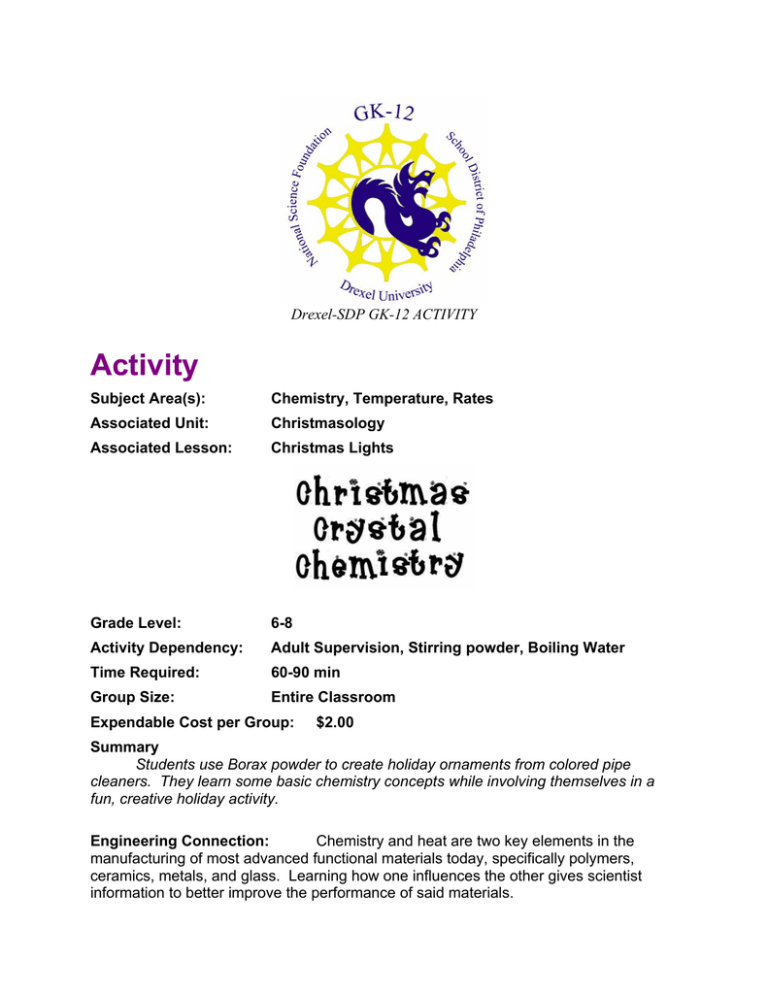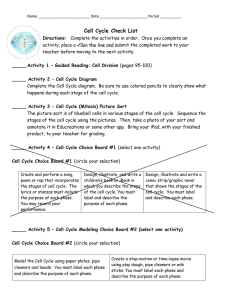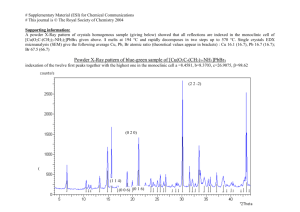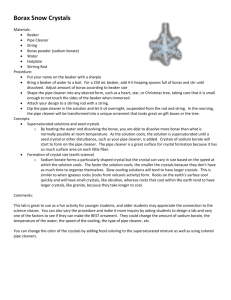Activity
advertisement

Drexel-SDP GK-12 ACTIVITY Activity Subject Area(s): Chemistry, Temperature, Rates Associated Unit: Christmasology Associated Lesson: Christmas Lights Grade Level: 6-8 Activity Dependency: Adult Supervision, Stirring powder, Boiling Water Time Required: 60-90 min Group Size: Entire Classroom Expendable Cost per Group: $2.00 Summary Students use Borax powder to create holiday ornaments from colored pipe cleaners. They learn some basic chemistry concepts while involving themselves in a fun, creative holiday activity. Engineering Connection: Chemistry and heat are two key elements in the manufacturing of most advanced functional materials today, specifically polymers, ceramics, metals, and glass. Learning how one influences the other gives scientist information to better improve the performance of said materials. Keywords: Chemistry, Temperature, Rates Educational Standards • Science: [PA] 3.2.7ABCD, 3.4.7AB, 3.7.7AB Learning Objectives After this lesson, students should be able to: • Predict the sizes of crystal formations through understanding of cooling rates • Construct an apparatus to test crystal formation out of solutions • Identify and illustrate a crystal using eyesight and a magnifying glass Materials List To share with the entire class: • Borax Powder (found in the detergent aisle of the grocery store) • A glass jar per student (styrofoam cups also work, but NO plastic cups!) • Colored pipe cleaners • Boiling water (so some sort of vessel and a hotplate) • Plastic spoons or stirrods • Large paper clips • A pencil • magnifying glass Introduction / Motivation This is a great holiday based activity. It involves dissolving an amount of crystal powder into very hot solution, this case being water. Since the water is hot, the molecules tend to spread apart from one another, allowing the crystals to dissolve within the solution. As the solution cools though, the crystals begin to have less and less places to stay, so they end up precipitating onto the pipe cleaners, thus forming a crystal-like ornament. Since the cooling is what forms the crystals, it is interesting to have a group of the students predict whether cooling the water faster or slower will change the shape or sizes of the crystals formed. Procedure With the Students 1. Begin boiling the water even before the lesson begins, this takes the most time and you will need a lot of water for a classroom of 20-24 kids. 2. After explaining the motivation above, reminding the students to write their hypothesis into their notebooks, you may allow them to bend their pipe cleaners 2 into shape. It is usually better that the sizes to be smaller, as the crystals will not form on the areas of the pipe cleaner that touch the sides of the cup later. 3. Once the pipe cleaner is bent, each student should take their paper clip and bend it around the pipe cleaner. It should then take the other end and place it around the pencil, which should then be placed on top of the styrofoam cup. Be sure to remind the students that their pipe cleaners should not be touching the sides. If they are comfortable with theirs, they may move to the next step. 4. Now add enough boiling water as to cover the entire pipe cleaner. After it is added the students may add 1 spoonful of powder to the solution and stir. They can then continue to stir in additional powder one spoonful at a time until the solution is no longer clear when settled. The crystals dissolve best when hot, so it is important to do this as safely and quickly as possible. 5. Once the solution is set and ready to go the students may pick a spot to cool their ornaments. Usually there is a heater in the classroom, so students may choose to place it near the heater for a slower cooling rate or by a window for a faster cooling rate. Try to encourage half the students to do one or the other, or they may be assigned. 6. A really nice ornament should take at least 24 hours to finish. I've even waited 2 days and they were perfect, this all depends on your scheduling. The cleaners should look as below: 7. As the students are excited, ask them to sketch a picture of the crystals on their pipe cleaners. Then you may pass around a magnifying glass(es) and have them sketch another picture of the crystals up close. They then can compare to their neighbors crystals or students who selected the other cooling cycle. 8. A fair assessment then is to ask the children what caused their crystals to be the size or shape they found them to be. If they can relate the formation to the cooling rates, then not only was this a fun, productive holiday activity, but a very successful introduction into solution chemistry. 3 Assessment: This activity is geared more towards critical thinking and executing an experimental plan, so in actuality the only real assessment is whether or not the student is able to form crystals on their ornaments. Safety Issues • Though this is obvious, please handle the boiling water with extreme care. I made all the children stand back at least 3 feet from me as I poured into the cups and watched them individually as they stirred in the powder. References http://owlhaven.wordpress.com/2006/10/17/crystalline/ http://britton.disted.camosun.bc.ca/snow/boraxsnowflake.html Owner Drexel University GK-12 Program Contributors: Adapted by Stephen Nonnenmann Copyright Copyright 2007 Drexel University GK12 Program. Reproduction permission is granted for nonprofit educational use Version: Mar 2007 4







